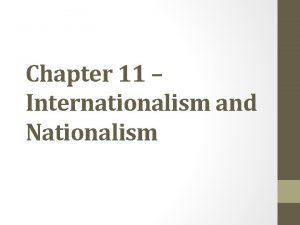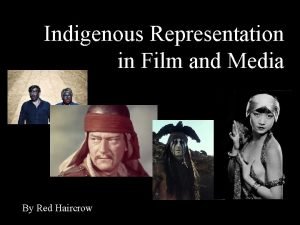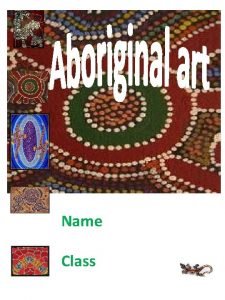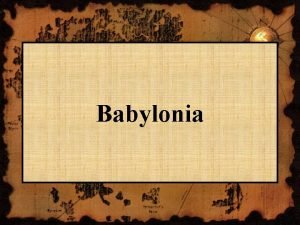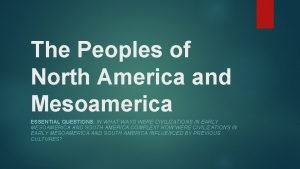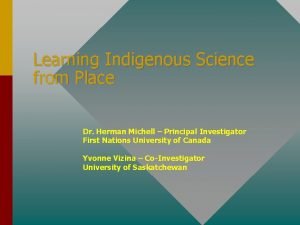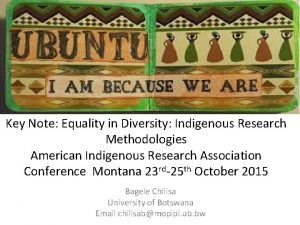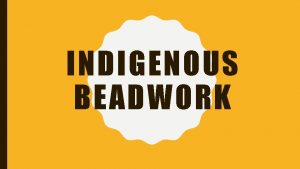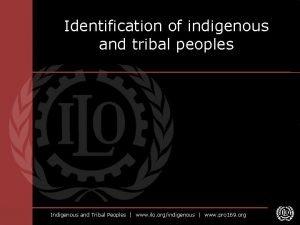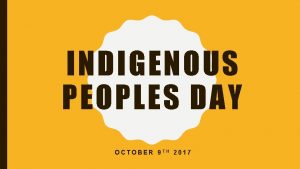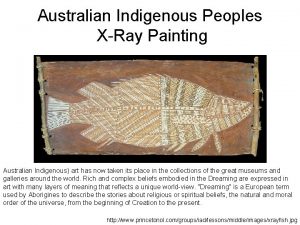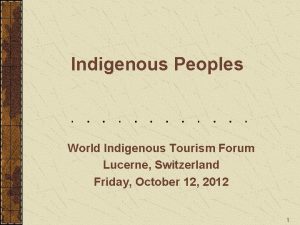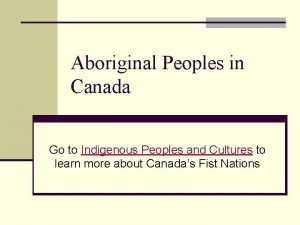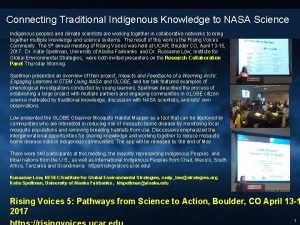The Importance of Indigenous Peoples and Traditional communities










- Slides: 10

The Importance of Indigenous Peoples and Traditional communities in the context of Global Warming REDD, Forest People and their Rights Amazon forest people and REDD Recognition of rights to land, territory and natural resources and the traditional way of life is key to the success of REDD design and implementation. REDD initiatives and case studies will be discussed by Amazon forest people Paula Moreira paulamoreira@ipam. org. br Lawyer, IPAM – Climate Change Programme Side Event UNFCCC– COP 14 Poznan, Poland – 6 th December 2008

Extractive Reserves Indigenous territories Other Protected Areas Brazilian Amazonian Biome State Limits Deforestation Forest Non-Forest

What role Traditional communities and Indigenous peoples have been playing in the conservation of tropical forests and its carbon stocks? • Some areas show clear signs of occurrence of deforestation • Deforested areas inside the Brazilian Amazon protected areas as a whole is very small: 1. 53% of its total area. • In indigenous lands this percentage is only 1. 1% and • In extractive reserves is 3%. • Consequently, the 282 indigenous lands and 61 extractive reserves in the Brazilian Amazon are preserving a forest carbon stock of about 15. 2 billion tons (32% of total carbon stock of the Amazon).

The Importance of Indigenous Peoples and Traditional communities in the context of Global Warming % of deforested areas Percentage of deforested areas in protected areas in the Brazilian Amazon Military Areas Question 28, pg. 45 Conservations Units of Integral Protection Indigenous Lands Extractive reserves Out of Conservations Units Type of Protected area

Traditional communities and indigenous people and the Protection of Forests • Traditional communities and indigenous peoples: key role in avoiding emissions of greenhouse gases from deforestation in their territories • Brazilian Amazon: protected areas inhabited by forest peoples total 110 million hectares (60% of the protected areas) • Major obstacles to the advance of deforestation • This lands avoid the significant potential emissions associated to greenhouse gases.

Traditional communities and indigenous people and the Protection of Forests • Simulations aimed at predicting the future deforestation, it was possible to calculate the potential emissions of indigenous lands and extractive reserves from 2008 to 2050. • If these areas were not protected, 5 billion tons of carbon would be emitted into the atmosphere by the year 2050 • ~= 2. 5 times the effort to reduce emissions of the first commitment period of the Kyoto Protocol, considering its effective implementation.

Traditional communities and indigenous people and the Protection of Forests • It is essential that any discussion focused on the benefits and compensations that should be attributed to the efforts on (REDD), as well as, the protection of the forests, recognize the important role that traditional communities and indigenous peoples have been playing and respond to their demands in order to promote the improvement of socio-environmental conditions in their territories. • Such improvements or benefits could be promoted, eg. in form of subsidies for the production of non-timber products and provision of basic rights to these populations, such as the right to the demarcation of their territories, which is frequently violated.

Side Event Structure Panel Discussion: • Manoel Silva da Cunha, President, Brazilian National Council of Rubber Tappers (CNS) • Francisco Avelino Batista Apunirã – Ethnoenvironmental Manager, Coordination of the Indigenous Organizations of the Brazilian Amazon (COIAB) • Victor Hugo Velaz – Confederation of Indigenous People of Bolivia (CIDOB) • Jorge Furagaro – President, Organization of Indigenous People of the Colombian Amazon (OPIAC)

LAUNCHING - ‘’Preguntas y Respuestas sobre Calentamiento Global’’ Booklet • In partnership with Amazon Alliance and COICA, IPAM has updated and produced a Spanish version the booklet including additional key issues. • Spanish and Portuguese electronic copy available at http: //www. climaedesmatamento. org. br/biblioteca

Cocktail Reception Tribute to the Rubber Tapper Chico Mendes, 20 Years After Chico Mendes Dream, the struggle for the Preservation of the Amazon and the issue of Reducing Emissions from Deforestation and Forest Degradation (REDD) Manoel Cunha – President, Brazilian National Council of Rubber Tappers (CNS) Francisco Apurinã – Ethno-Environmental Director, Coordination of the Indigenous Organizations of the Brazilian Amazon (COIAB)
 World council of indigenous peoples
World council of indigenous peoples Indigenous peoples
Indigenous peoples Hydrarch succession definition
Hydrarch succession definition Peter burrawange datjin
Peter burrawange datjin Similarities between inca maya and aztec
Similarities between inca maya and aztec Many territories and peoples controlled by one government
Many territories and peoples controlled by one government The peoples of north america and mesoamerica
The peoples of north america and mesoamerica Indigenous axiology
Indigenous axiology Medicine wheel colours
Medicine wheel colours Examples of indigenous
Examples of indigenous What is indigenous research
What is indigenous research
